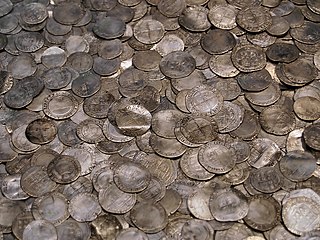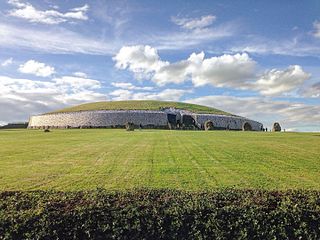
A hoard or "wealth deposit" is an archaeological term for a collection of valuable objects or artifacts, sometimes purposely buried in the ground, in which case it is sometimes also known as a cache. This would usually be with the intention of later recovery by the hoarder; hoarders sometimes died or were unable to return for other reasons before retrieving the hoard, and these surviving hoards might then be uncovered much later by metal detector hobbyists, members of the public, and archaeologists.

The Únětice culture is an archaeological culture at the start of the Central European Bronze Age, dated roughly to about 2300–1800 BC. The eponymous site for this culture, the village of Únětice, is located in the central Czech Republic, northwest of Prague. Today, the Únětice culture is known from about 1,400 sites in the Czech Republic and Slovakia, 550 sites in Poland, and, in Germany, about 500 sites and loose finds locations. The Únětice culture is also known from north-eastern Austria, and from western Ukraine.

The Ochre Coloured Pottery culture (OCP) is a Bronze Age culture of the Indo-Gangetic Plain "generally dated 2000-1500 BCE," extending from eastern Punjab to northeastern Rajasthan and western Uttar Pradesh. Artefacts of this culture show similarities with both the Late Harappan culture and the Vedic culture. Archaeologist Akinori Uesugi considers it as an archaeological continuity of the previous Harappan Bara style, while according to Parpola, the find of carts in this culture may reflect an Indo-Iranian migration into the India subcontinent, in contact with Late Harappans. The OCP marked the last stage of the North Indian Bronze Age and was succeeded by the Iron Age black and red ware culture and the Painted Grey Ware culture.

Lovas is a village and seat of municipality in the Vukovar-Syrmia County of eastern Croatia, located on the slopes of Fruška Gora, a few kilometers south of the main road connecting Vukovar with Ilok. Lovas has a population of 1,214 (2011), and its municipality also includes the smaller village of Opatovac which is located to the north, at the Danube. Lovas is underdeveloped municipality which is statistically classified as the First Category Area of Special State Concern by the Government of Croatia.

The prehistory of Ireland has been pieced together from archaeological evidence, which has grown at an increasing rate over the last decades. It begins with the first evidence of humans in Ireland around 10,500 BC, and finishes with the start of the historical record around 400 AD. Both of these dates are later than for much of Europe and all of the Near East. The prehistoric period covers the Palaeolithic, Mesolithic, Neolithic, Bronze Age and Iron Age societies of Ireland. For much of Europe, the historical record begins when the Romans invaded; as Ireland was not invaded by the Romans its historical record starts later, with the coming of Christianity.

Copper Hoard Culture describes find-complexes which mainly occur in the western Ganges-Yamuna doab in the northern part of the Indian subcontinent. They occur mostly in hoards large and small, and are dated to the first half of the 2nd millennium BCE, although very few derive from controlled and dateable excavation contexts. The copper hoards are associated with the Ochre Coloured Pottery (OCP), which is closely associated with the Late Harappan phase of the IVC. Associations with the Indo-Aryan migrants of the second millennium BCE have also been proposed, though association with the Vedic Aryans is problematic, since the hoards are found east of the territory of the Vedic Aryans.

The Staffordshire Hoard is the largest hoard of Anglo-Saxon gold and silver metalwork yet found. It consists of almost 4,600 items and metal fragments, amounting to a total of 5.1 kg (11 lb) of gold, 1.4 kg (3 lb) of silver and some 3,500 pieces of garnet cloisonné jewellery.

The Stirling torcs make up a hoard of four gold Iron Age torcs, a type of necklace, all of which date to between 300 and 100 BC and which were buried deliberately at some point in antiquity. They were found by a metal detectorist in a field near Blair Drummond, Stirlingshire, Scotland on 28 September 2009. The hoard has been described as the most significant discovery of Iron Age metalwork in Scotland and is said to be of international significance. The torcs were valued at £462,000, and after a public appeal were acquired for the National Museums of Scotland in March 2011.

Rainham is a suburb of East London, England, in the London Borough of Havering. Historically an ancient parish in the county of Essex, Rainham is 13.6 miles (21.9 km) east of Charing Cross and is surrounded by a residential area, which has grown from the historic village, to the north and a commercial area, fronting the River Thames, to the south. As part of the suburban growth of London in the 20th century, Rainham significantly expanded and increased in population, becoming part of Hornchurch Urban District in 1934, and has formed part of Greater London since 1965. The economic history of Rainham is underpinned by a shift from agriculture to industry and manufacture and is now in a period of regeneration, coming within the London Riverside section of the Thames Gateway redevelopment area.

The National Museum of Ireland – Archaeology is a branch of the National Museum of Ireland located on Kildare Street in Dublin, Ireland, and dealing with Irish and other antiquities. In general, the museum covers the history of Ireland from the Stone Age to the Late Middle Ages. Many important artefacts from the museum were featured in The Irish Times feature and book A History of Ireland in 100 Objects.

Samrong Sen on the east bank of the Stueng Chinit River is a prehistoric archaeological site in the Kampong Chhnang Province, Cambodia. Consisting of a very large fluviatile shell midden, it flourished in particular from 1500 BC to 500 BC.
The Furness Hoard is a hoard of Viking silver coins and other artefacts dating to the 9th and 10th Century that was discovered in Furness, Cumbria, England in May 2011 by an unnamed metal detectorist. The exact location of the find, as well as the names of the finder and the landowner, have not been made public.

Nonferrous Archaeometallurgy in the Southern Levant refers to the archaeological study of non-Iron-related metal technology in the region of the Southern Levant during the Chalcolithic period and Bronze Age from approximately 4500BC to 1000BC.

Saruq Al Hadid is an archaeological site in Dubai, United Arab Emirates (UAE), and stands as one of the most important and enigmatic historical sites in the country. Findings from the site are displayed in a museum with the same name in the city of Dubai. The site was originally discovered by the ruler of Dubai, Sheikh Mohammed bin Rashid Al Maktoum, while flying his helicopter across the desert.

The Canterbury Treasure is an important late Roman silver hoard found in the city of Canterbury, Kent, south-east England in 1962, and now in the Roman Museum, Canterbury, Kent. Copies of the main items are also kept in the British Museum.

The Galloway Hoard, now in the National Museum of Scotland, is a hoard of more than 100 gold and silver objects from the Viking Age discovered in the historical county of Kirkcudbrightshire in Dumfries and Galloway in Scotland in September 2014. Found on Church of Scotland land, the hoard has been described by experts as "one of the most significant Viking hoards ever found in Scotland". It was discovered by a metal detector enthusiast who reported the find to the authorities. A county archaeologist carried out an excavation which unearthed a rich and unusually varied collection of jewellery from the Viking world, Anglo-Saxon England and elsewhere in Europe. It is thought that the hoard was buried some time in the mid-ninth or tenth century, though it is not known why it was buried.

The Dowris Hoard is the name of an important Bronze Age hoard of over 200 objects found in Dowris, County Offaly, Ireland. Items from the deposit are currently split between two institutions: the National Museum of Ireland in Dublin and the British Museum in London.

The Wylye Hoard is a hoard of Bronze Age jewellery, discovered by metal detectorists in a cultivated field, north-east of the village of Wylye, Wiltshire, England, in 2012. In February 2014, it was declared treasure, under the terms of the Treasure Act 1996.


















